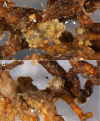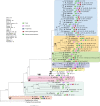Multigene phylogeny of root-knot nematodes and molecular characterization of Meloidogyne nataliei Golden, Rose & Bird, 1981 (Nematoda: Tylenchida)
- PMID: 31409860
- PMCID: PMC6692364
- DOI: 10.1038/s41598-019-48195-0
Multigene phylogeny of root-knot nematodes and molecular characterization of Meloidogyne nataliei Golden, Rose & Bird, 1981 (Nematoda: Tylenchida)
Abstract
The root-knot nematodes of the genus Meloidogyne are highly adapted, obligate plant parasites, consisting of nearly one hundred valid species, and are considered the most economically important group of plant-parasitic nematodes. Six Meloidogyne species: M. arenaria, M. hapla, M. incognita, M. microtyla, M. naasi and M. nataliei were previously reported in Michigan, USA. For this study, Meloidogyne nataliei was isolated from the grapevine Vitis labrusca from the type locality in Michigan, USA, and was characterized using isozyme analysis and ribosomal and mitochondrial gene sequences. No malate dehydrogenase activity was detected using macerate of one, five, six, seven or ten females of M. nataliei per well. However, one strong band (EST = S1; Rm: 27.4) of esterase activity was detected when using homogenates of ten egg-laying females per well. Phylogenetic analyses of sequences of the partial 18S ribosomal RNA, D2-D3 of 28S rRNA, internal transcribed spacer of rRNA, mitochondrial cytochrome oxidase subunit I genes and the cytochrome oxidase subunit II-16S rRNA intergeneric fragment from fifty-five valid Meloidogyne species and M. nataliei were conducted using Bayesian inference and maximum likelihood methods. From these results, we infer 11 distinct clades among studied species, with M. nataliei and M. indica composing a basal lineage. Seventy five percent of these species belong to seven clades within the Meloidogyne superclade. Characterization of these clades is provided and evolutionary trends within the root-knot nematodes are discussed.
Conflict of interest statement
The authors declare no competing interests.
Figures




References
-
- Moens, M., Perry, R. N. & Starr, J. L. Meloidogyne species – a diverse group of novel and important plant parasites in Root-knot Nematodes (eds Perry, R. N., Moens, M. & Starr, J. L.) 1–17 (CAB International: Cambridge, MA, 2009).
-
- Hunt, D. J. & Handoo, Z. A. Taxonomy, identification and principal species in Root-knot Nematodes (eds Perry, R. N., Moens, M. & Starr, J. L.) 55–97 (CAB International: Cambridge, MA, 2009).
-
- Bird, G. W. & Warner, F. Nematodes and nematologists of Michigan in Plant Parasitic Nematodes in Sustainable Agriculture of North America. Vol. 2 – Northeastern, Midwestern and Southern USA (eds Subbotin, S. A. & Chitambar, J. J.) 57–86 (Springer, 2018).
MeSH terms
Substances
LinkOut - more resources
Full Text Sources
Research Materials

